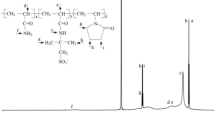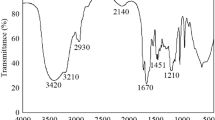Abstract
High temperature and a large salt content weaken the surface hydration ability of clay particles in drilling fluid, reduce zeta potential, agglomerate clay particles, increase particle size, and destroy the stability of drilling mud. A filtrate reducer is required, therefore, to maintain the zeta potential of the clay, prevent the agglomeration of clay particles, and maintain good performance of the drilling mud at high temperature and high salt content. To prepare temperature- and salt-resistant polymer filtrate reducer, a betaine monomer was synthesized and copolymerized with a conventional monomer. A betaine monomer 3-(dimethyl (4-vinyl benzyl) ammonia) propyl sulfonate (DVBAPS) was synthesized and then used to create a copolymer filtrate reducer. The copolymer filtrate reducer, referred to as PAAAND, was prepared by free radical copolymerization with 2-acrylamide-2-methylpropane sulfonic acid, acrylic acid, N-vinyl pyrrolidone, acrylamide, and DVBAPS. The optimum synthesis conditions were determined by single factor evaluation, and the chemical structure of the PAAAND was confirmed by Fourier-transform infrared spectroscopy and 1H nuclear magnetic resonance spectroscopy. Results from particle-size distribution and zeta-potential measurements showed that PAAAND increased the zeta potential of clay particles and the distribution width of particles size, which served to maintain the stability of the drilling mud under high-temperature and high-salt conditions. The results of scanning electron microscopy showed that PAAAND made the filter cake formed by clay particles smoother and denser, which reduced filtration loss. The reduction in filtrate loss continued even after aging at high temperature, and, thus, PAAAND performed better than commercial products.














Similar content being viewed by others
Data Availability
The data that support this study are available in the article.
References
Abu-Jdayil, B., & Ghannam, M. (2014). The Modification of Rheological Properties of Sodium Bentonite-water Dispersions with Low Viscosity CMC Polymer Effect. Energy Sources Part a-Recovery Utilization and Environmental Effects, 36(10), 1037–1048. https://doi.org/10.1080/15567036.2010.551260
Chang, X., Sun, J., Zhang, F., Lv, K., Zhou, X., Wang, J., & Zhao, J. (2020). A novel zwitterionic quaternary copolymer as a fluid-loss additive for water-based drilling fluids. Energy Sources Part A: Recovery Utilization and Environmental Effects, 1–14. https://doi.org/10.1080/15567036.2020.1766600
Dai, Z. W., Sun, J. S., Wang, Y., & Iop. (2019). A Polymer-based Drilling Fluid with High Temperature, Salt and Calcium Resistance Property. In 4th International Conference on Advances in Energy Resources and Environment Engineering (Vol. 237). https://doi.org/10.1088/1755-1315/237/5/052058
De Monaco Lopes, B., Lessa, V. L., Silva, B. M., Carvalho Filho, M. A. D. S., Schnitzler, E., & Lacerda, L. G. (2015). Xanthan gum: properties, production conditions, quality and economic perspective. Journal of Food and Nutrition Research (Bratislava, Slovakia), 54(3), 185–194.
Gurkaynak, A., Tubert, F., Yang, J., Matyas, J., Spencer, J. L., & Gryte, C. C. (1996). High-temperature degradation of poly(acrylic acid) in aqueous solution. Journal of Polymer Science, Part A: Polymer Chemistry, 34(3), 349–355. https://doi.org/10.1002/(SICI)1099-0518(199602)34:3<349::AID-POLA3>3.0.CO;2-P
Hasan, M. L., Abidin, N. A. Z., & Singh, A. (2018). The rheological performance of guar gum and castor oil as additives in water-based drilling fluid. Materials Today-Proceedings, 5(10), 21810–21817.
Hermansson, M. (1999). The DLVO theory in microbial adhesion. Colloids and Surfaces, B: Biointerfaces, 14(1-4), 105–119. https://doi.org/10.1016/S0927-7765(99)00029-6
Lee, W.-F., & Tsai, C.-C. (1994). Synthesis and solubility of the poly(sulfobetaine)s and the corresponding cationic polymers: 1. Synthesis and characterization of sulfobetaines and the corresponding cationic monomers by nuclear magnetic resonance spectra. Polymer, 35(10), 2210–2217. https://doi.org/10.1016/0032-3861(94)90253-4
Li, H.-M., Zhuang, J., Liu, H.-B., Feng, L., & Dong, W. (2012). Preparation and property of 2-acrylamide-2-methylpropanesulfonic acid/acrylamide/sodium styrene sulfonate as fluid loss agent for oil well cement. Polymer Engineering & Science, 52(2), 431–437. https://doi.org/10.1002/pen.22101
Li, Z., Pu, X., Tao, H., Liu, L., & Su, J. (2014). Synthesis and properties of acrylamide 2-acrylamido-2-methypropane sulfonic acid sodium styrene sulfonate N-vinyl pyrrolidone quadripolymer and its reduction of drilling fluid filtration at high temperature and high salinity. Journal of Polymer Engineering, 34(2), 125–131. https://doi.org/10.1515/polyeng-2013-0257
Liaw, D. J., & Lin, M. C. (1990). Aqueous solution properties of an ampholytic poly[3-dimethyl(acryloyloxyethyl) ammonium propane sulfonate]. Journal of the Chinese Institute of Chemical Engineers, 21(1), 13–20.
Lin, L., & Luo, P. (2015). Amphoteric hydrolyzed poly(acrylamide/dimethyl diallyl ammonium chloride) as a filtration reducer under high temperatures and high salinities. Journal of Applied Polymer Science, 132(10). https://doi.org/10.1002/app.41581
Lin, M., Li, M., Wang, Z., & Wu, Z. (2009). A Study of Thermal Stability of Linked Polymer Solution. Journal of Dispersion Science and Technology, 30(6), 753–756. https://doi.org/10.1080/01932690802643154
Liu, L., Pu, X., Tao, H., Deng, Q., & Luo, A. (2018). Synthesis and characterization of comb-shaped copolymer as a filtration reducer and comparison with counterparts. RSC Advances, 8(21), 11424–11435. https://doi.org/10.1039/c7ra13255g
Liu, F., Zhang, Z., Wang, Z., Dai, X., Chen, M., & Zhang, J. (2019). Novel lignosulfonate/N, N-dimethylacrylamide/γ-methacryloxypropyl trimethoxy silane graft copolymer as a filtration reducer for water-based drilling fluids. Journal of Applied Polymer Science, 137(2). https://doi.org/10.1002/app.48274
Liu, K., Du, H. S., Zheng, T., Liu, H. Y., Zhang, M., Zhang, R., Li, H. M., Xie, H. X., Zhang, X. Y., Ma, M. G., & Si, C. L. (2021). Recent advances in cellulose and its derivatives for oilfield applications. Carbohydrate Polymers, 259, Article 117740. https://doi.org/10.1016/j.carbpol.2021.117740
Ma, X., Zhu, Z., Shi, W., & Hu, Y. (2016). Synthesis and application of a novel betaine-type copolymer as fluid loss additive for water-based drilling fluid. Colloid and Polymer Science, 295(1), 53–66. https://doi.org/10.1007/s00396-016-3980-x
Mao, H., Qiu, Z., Shen, Z., & Huang, W. (2015). Hydrophobic associated polymer based silica nanoparticles composite with core–shell structure as a filtrate reducer for drilling fluid at utra-high temperature. Journal of Petroleum Science and Engineering, 129, 1–14. https://doi.org/10.1016/j.petrol.2015.03.003
Mao, H., Wang, W., Ma, Y., & Huang, Y. (2020). Synthesis, characterization and properties of an anionic polymer for water-based drilling fluid as an anti-high temperature and anti-salt contamination fluid loss control additive. Polymer Bulletin, 78, 2483–2503. https://doi:org/10.1007/s00289-020-03227-y
Murodov, M. M., Rahmanberdiev, G. R., Khalikov, M. M., Egamberdiev, E. A., Negmatova, K. C., Saidov, M. M., & Mahmudova, N. (2012). Endurance of High Molecular Weight Carboxymethyl Cellulose in Corrosive Environments. In A. Damore, L. Grassia, & D. Acierno (Eds.), 6th International Conference on Times of Polymers (Vol. 1459, pp. 309-311). https://doi.org/10.1063/1.4738479
Pashley, R. M., & Israelachvili, J. N. (1984). DLVO and hydration forces between mica surfaces in magnesium(2+), calcium(2+), strontium(2+), and barium(2+) chloride solutions. Journal of Colloid and Interface Science, 97(2), 446–455. https://doi.org/10.1016/0021-9797(84)90316-3
Perricone, A. C., Enright, D. P., & Lucas, J. M. (1986). Vinyl Sulfonate Copolymers for High-Temperature Filtration Control of Water-Based Muds. SPE Drilling Engineering, 1(05), 358–364. https://doi.org/10.2118/13455-pa
Roux, F. X., Audebert, R., & Quivoron, C. (1973). Pyrolysis of acrylic and methylacrylic acid polymers at moderate temperatures. European Polymer Journal, 9(8), 815–825.
Sharma, G., Sharma, S., Kumar, A., Al-Muhtaseb, A. H., Naushad, M., Ghfar, A. A., Mola, G. T., & Stadler, F. J. (2018). Guar gum and its composites as potential materials for diverse applications: A review. Carbohydrate Polymers, 199, 534–545. https://doi.org/10.1016/j.carbpol.2018.07.053
Shen, H. K., Lv, K. H., Huang, X. B., Liu, J. P., Bai, Y. R., Wang, J. T., & Sun, J. S. (2020). Hydrophobic-associated polymer-based laponite nanolayered silicate composite as filtrate reducer for water-based drilling fluid at high temperature. Journal of Applied Polymer Science, 137(18), Article 48608. https://doi.org/10.1002/app.48608
Smith, P. S., Browne, S. V., Heinz, T. J., & Wise, W. V. (1996). Drilling Fluid Design to Prevent Formation Damage in High Permeability Quartz Arenite Sandstones. SPE Annual Technical Conference and Exhibition.
Tang, X., Yuan, B., Yang, Y. G., & Xie, Y. Q. (2016). Preparation and performance of AMPS/AA/DMAA/SA copolymer as a filtrate reducer for oil well cementing. Journal of Applied Polymer Science, 133(33), Article 43824. https://doi.org/10.1002/app.43824
Wang, G., Fan, H., Jiang, G., Li, W., Ye, Y., Liu, J., Kong, X., Zhong, Z., & Qian, F. (2020). Rheology and fluid loss of a polyacrylamide-based micro-gel particles in a water-based drilling fluid. Materials Express, 10(5), 657–662. https://doi.org/10.1166/mex.2020.1687
Xiao, S., Zhang, Y., Shen, M., Chen, F., Fan, P., Zhong, M., Ren, B., Yang, J., & Zheng, J. (2018). Structural Dependence of Salt-Responsive Polyzwitterionic Brushes with an Anti-Polyelectrolyte Effect. Langmuir, 34(1), 97–105. https://doi.org/10.1021/acs.langmuir.7b03667
Xiong, B., Loss, R. D., Shields, D., Pawlik, T., Hochreiter, R., Zydney, A. L., & Kumar, M. (2018). Polyacrylamide degradation and its implications in environmental systems. NPJ Clean Water, 1(1), 1–9. https://doi.org/10.1038/s41545-018-0016-8
Xiping, M., Zhongxiang, Z., Daiyong, H., & Wei, S. (2017). Synthesis and performance evaluation of a water-soluble copolymer as high-performance fluid loss additive for water-based drilling fluid at high temperature. Russian Journal of Applied Chemistry, 89(10), 1694–1705. https://doi.org/10.1134/s1070427216100190
Yang, M.-H. (1998). The two-stages thermal degradation of polyacrylamide. Polymer Testing, 17(3), 191–198. https://doi.org/10.1016/S0142-9418(97)00036-6
Yang, P., Li, T. B., Wu, M. H., Zhu, X. W., & Sun, X. Q. (2015). Analysis of the effect of polyanionic cellulose on viscosity and filtrate volume in drilling fluid. Materials Research Innovations, 19, 12–16. https://doi.org/10.1179/1432891715z.0000000001329
Yuan, J., Zhang, D., He, X., Ni, Y., Che, L., Wu, J., Wu, B., Wang, Y., Wang, S., Sha, D., Zheng, S. Y., & Yang, J. (2021). Cationic peptide-based salt-responsive antibacterial hydrogel dressings for wound healing. International Journal of Biological Macromolecules, 190, 754–762. https://doi.org/10.1016/j.ijbiomac.2021.09.019
Zheng, X. H., Yang, S. W., & Lei, Z. L. (2013). Synthesis, Characterization, and Evaluation of a Fluid Loss Agent for High-Temperature Drilling Fluid. American Laboratory, 45(10), 22–25.
Zheng, W. L., Wu, X. M., & Huang, Y. M. (2020). Impact of polymer addition, electrolyte, clay and antioxidant on rheological properties of polymer fluid at high temperature and high pressure. Journal of Petroleum Exploration and Production Technology, 10(2), 663–671. https://doi.org/10.1007/s13202-019-0732-8
Zheng, S. Y., Mao, S., Yuan, J., Wang, S., He, X., Zhang, X., Du, C., Zhang, D., Wu, Z. L., & Yang, J. (2021). Molecularly Engineered Zwitterionic Hydrogels with High Toughness and Self-Healing Capacity for Soft Electronics Applications. Chemistry of Materials, 33(21), 8418–8429. https://doi.org/10.1021/acs.chemmater.1c02781
Zhao, Z., Pu, X., Xiao, L., Wang, G., Su, J., & He, M. (2015). Synthesis and properties of high temperature resistant and salt tolerant filtrate reducer N,N-dimethylacrylamide 2-acrylamido-2-methyl-1-propyl dimethyl diallyl ammonium chloride N-vinylpyrrolidone quadripolymer. Journal of Polymer Engineering, 35(7), 627-635. doi:10.1515/polyeng-2014-0260
Acknowledgments
The authors are very grateful for the bentonite provided by Hualai Dingsheng and to tutor Lin Ling for providing the laboratory, instruments, and reagents.
Funding
There is no funding for this article.
Author information
Authors and Affiliations
Corresponding author
Ethics declarations
Conflict of Interest
There are no other relationships or activities that could appear to have influenced the submitted work. The authors declare that they have no conflict of interest. All authors agree to submit for publication.
Rights and permissions
About this article
Cite this article
Yunxiang, L., Ling, L., Wenke, Y. et al. Synthesis and Evaluation of Betaine Copolymer Filtrate Reducer for Drilling Mud. Clays Clay Miner. 70, 252–269 (2022). https://doi.org/10.1007/s42860-022-00181-w
Accepted:
Published:
Issue Date:
DOI: https://doi.org/10.1007/s42860-022-00181-w




